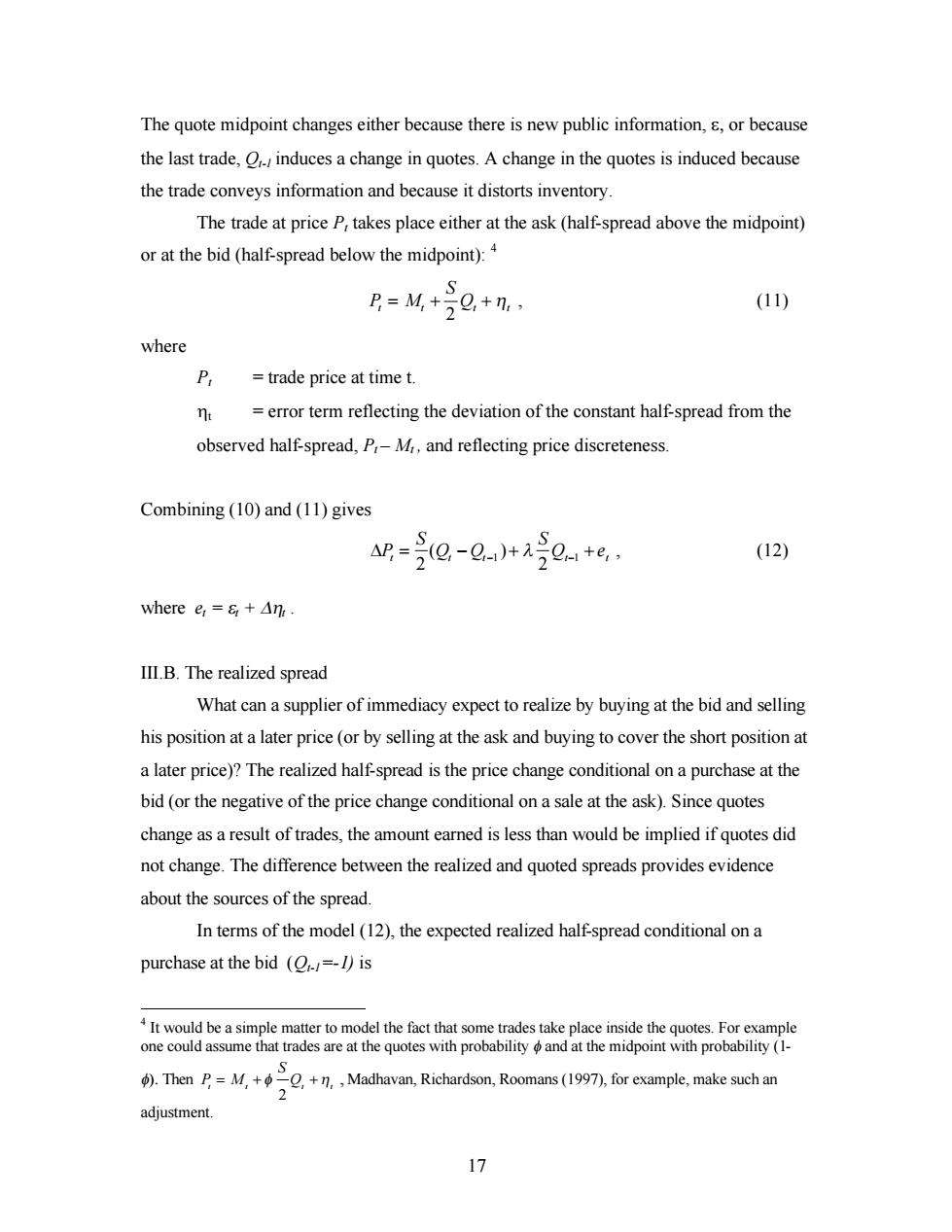正在加载图片...

The quote midpoint changes either because there is new public information,8,or because the last trade,O induces a change in quotes.A change in the quotes is induced because the trade conveys information and because it distorts inventory. The trade at price P,takes place either at the ask (half-spread above the midpoint) or at the bid (half-spread below the midpoint):4 B=M+20,+n, (11) where P trade price at time t. nt error term reflecting the deviation of the constant half-spread from the observed half-spread,P,-M,and reflecting price discreteness. Combining (10)and(11)gives S (12) where e,=e+△nk, III.B.The realized spread What can a supplier of immediacy expect to realize by buying at the bid and selling his position at a later price(or by selling at the ask and buying to cover the short position at a later price)?The realized half-spread is the price change conditional on a purchase at the bid (or the negative of the price change conditional on a sale at the ask).Since quotes change as a result of trades,the amount earned is less than would be implied if quotes did not change.The difference between the realized and quoted spreads provides evidence about the sources of the spread. In terms of the model (12),the expected realized half-spread conditional on a purchase at the bid (.1=-1)is 4 It would be a simple matter to model the fact that some trades take place inside the quotes.For example one could assume that trades are at the quotes with probability and at the midpoint with probability (1- )Then P=M,++n,,Madhavan,Richardson,Roomans (1997),for example,make such an adjustment. 1717 The quote midpoint changes either because there is new public information, e, or because the last trade, Qt-1 induces a change in quotes. A change in the quotes is induced because the trade conveys information and because it distorts inventory. The trade at price Pt takes place either at the ask (half-spread above the midpoint) or at the bid (half-spread below the midpoint): 4 P M S t = t + Qt + t 2 h , (11) where Pt = trade price at time t. ht = error term reflecting the deviation of the constant half-spread from the observed half-spread, Pt – Mt , and reflecting price discreteness. Combining (10) and (11) gives DP S Q Q S Q e t = t - t - + t- + t 2 2 1 1 ( ) l , (12) where et = et + Dht . III.B. The realized spread What can a supplier of immediacy expect to realize by buying at the bid and selling his position at a later price (or by selling at the ask and buying to cover the short position at a later price)? The realized half-spread is the price change conditional on a purchase at the bid (or the negative of the price change conditional on a sale at the ask). Since quotes change as a result of trades, the amount earned is less than would be implied if quotes did not change. The difference between the realized and quoted spreads provides evidence about the sources of the spread. In terms of the model (12), the expected realized half-spread conditional on a purchase at the bid (Qt-1=-1) is 4 It would be a simple matter to model the fact that some trades take place inside the quotes. For example one could assume that trades are at the quotes with probability f and at the midpoint with probability (1- f). Then 2 , t t t t S P = M Q + + f h Madhavan, Richardson, Roomans (1997), for example, make such an adjustment